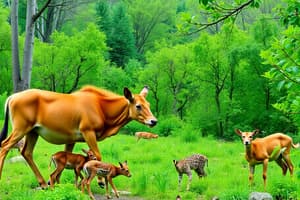Podcast
Questions and Answers
What is the population growth rate?
What is the population growth rate?
The rate of growth for a population, which is a group of organisms of one species in a specific area.
What does a J-shaped curve represent?
What does a J-shaped curve represent?
Exponential growth.
What is exponential growth?
What is exponential growth?
Growth pattern in which the individuals in a population reproduce at a constant rate.
Describe an S-shaped curve.
Describe an S-shaped curve.
What is logistic growth?
What is logistic growth?
Define birth rate.
Define birth rate.
What does death rate refer to?
What does death rate refer to?
What is zero population growth?
What is zero population growth?
What is reproductive potential?
What is reproductive potential?
Define carrying capacity.
Define carrying capacity.
What are limiting factors?
What are limiting factors?
Define population density.
Define population density.
What are density dependent factors?
What are density dependent factors?
Define density independent factors.
Define density independent factors.
What is a boom or bust cycle?
What is a boom or bust cycle?
What does population dispersion refer to?
What does population dispersion refer to?
What is clumped dispersion?
What is clumped dispersion?
Define uniform dispersion.
Define uniform dispersion.
What is random dispersion?
What is random dispersion?
What is life span?
What is life span?
Flashcards are hidden until you start studying
Study Notes
Population Dynamics
- Population Growth Rate: Measure of growth in a specific area's organisms of one species.
- Exponential Growth: Continuous reproduction at a constant rate, leading to J-shaped growth curves in graphs.
- Logistic Growth: Growth pattern where population growth slows or halts after exponential growth due to resource limitations, depicted as S-shaped curves.
- Zero Population Growth: Condition where a population's size remains stable, with no increase or decrease in numbers.
Birth and Death Metrics
- Birth Rate: The frequency of births within a population over a designated time frame.
- Death Rate: The frequency of deaths within a population over a specified period.
Growth Limits and Capacity
- Reproductive Potential: Maximum offspring an individual can produce, influencing population growth.
- Carrying Capacity: The maximum population size that an environment can sustain without degrading.
- Limiting Factors: Environmental conditions that restrict population growth, categorized as density-dependent or density-independent.
Population Density Concepts
- Population Density: Measurement of individuals present in a given area, affecting resource availability and competition.
- Density Dependent Factors: Factors like food, territory, shelter, and disease that influence populations based on the number of individuals present.
- Density Independent Factors: Unrelated to population density; these include natural disasters that impact all populations similarly.
Population Behaviors
- Boom or Bust Cycle: Cyclic growth patterns with periods of rapid increase and decline due to factors like seasonality and predator-prey interactions.
- Population Dispersion: Distribution of individuals in a habitat, which can be clumped, uniform, or random.
Dispersion Patterns
- Clumped Dispersion: Unequal density distribution, often due to resource concentration.
- Uniform Dispersion: Even distribution across a habitat, reducing competition (e.g., desert cacti).
- Random Dispersion: Uneven dispersal without a specific pattern, exemplified by dandelions.
Lifespan
- Life Span: The maximum duration an individual can potentially live.
Studying That Suits You
Use AI to generate personalized quizzes and flashcards to suit your learning preferences.




